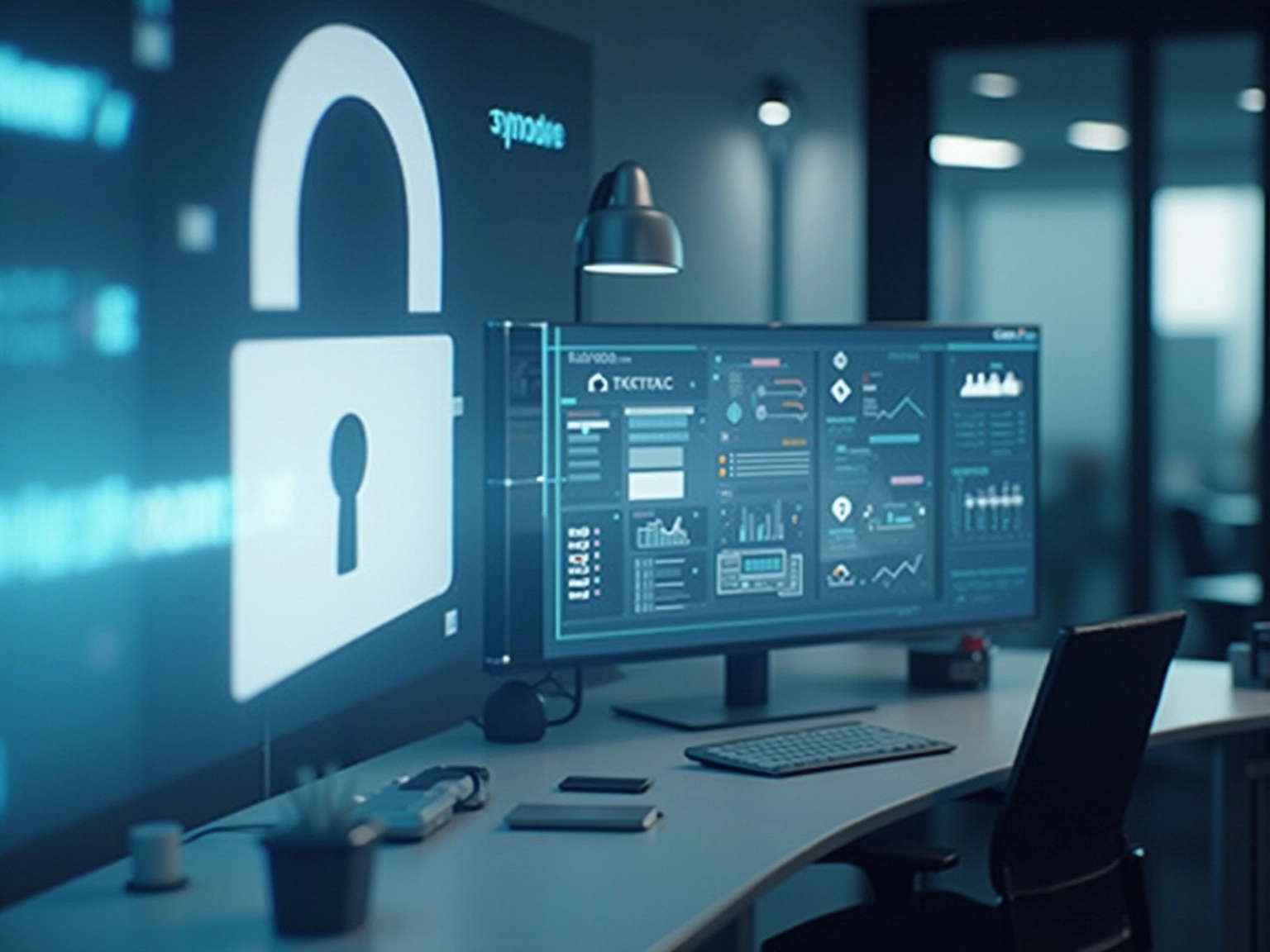Overview
The article highlights best practices for secure file sharing in business, underscoring the critical importance of compliance and security in safeguarding sensitive information. It delineates effective strategies, such as:
- Implementing strong passwords
- Utilizing multi-factor authentication
- Conducting thorough employee training
Moreover, it draws attention to the financial and reputational risks associated with non-compliance with regulations like GDPR and HIPAA. This serves to emphasize the urgent necessity for robust data protection measures in today’s increasingly complex digital landscape.
Key Highlights:
- Secure file sharing is essential for protecting sensitive business information from unauthorized access and breaches.
- The cybersecurity market is projected to reach $212 billion by 2025, indicating the growing need for robust data protection strategies.
- Small businesses face significant vulnerabilities, with only 17% having cyber insurance, highlighting the financial risks of inadequate cybersecurity.
- Compliance with regulations like GDPR and HIPAA is crucial, as non-compliance can lead to severe penalties and reputational damage.
- Best practices for secure file sharing include using strong passwords, implementing multi-factor authentication, and conducting regular safety audits.
- Emerging technologies such as AI, zero trust frameworks, and blockchain are expected to enhance secure file sharing methods in the future.
- Employee training is vital for recognizing phishing attempts and understanding data sensitivity, which helps mitigate risks of data breaches.
- Platforms like Glasscubes offer GDPR-compliant solutions, improving efficiency and client engagement while ensuring secure document exchange.
- Companies that adopt secure file sharing practices report significant improvements in client response times and operational efficiency.
Introduction
In a world increasingly defined by digital interactions, the significance of secure file sharing is paramount, particularly for businesses managing sensitive data such as accounting firms. As cyber threats escalate, grasping the complexities of secure file sharing becomes not merely advantageous but vital for sustaining client trust and ensuring regulatory compliance.
With staggering projections indicating that the cybersecurity market will surge to $212 billion by 2025, organizations must acknowledge the pressing necessity to adopt robust data protection strategies.
This article explores the essential elements of secure file sharing, examining:
- Best practices
- Emerging technologies
- The crucial role of employee training in protecting sensitive information
By prioritizing these strategies, businesses can adeptly navigate the challenges of data protection while enhancing operational efficiency and client satisfaction.
Understanding Secure File Sharing: A Business Necessity
Secure file sharing for business encompasses the techniques and technologies employed to transmit documents while safeguarding data from unauthorised access and breaches. In an era where data breaches are alarmingly prevalent, grasping the nuances of secure file sharing for business is not merely advantageous; it is imperative for companies, especially accounting firms. This practice ensures that sensitive information—ranging from financial records to personal data—is transmitted securely through secure file sharing for business, thereby mitigating the risks posed by cyber threats.
The significance of protected document exchange is underscored by the striking forecast that the cybersecurity market is projected to reach $212 billion by the end of 2025, reflecting the growing recognition of the need for robust data protection strategies. This expansion emphasises the necessity for accounting firms to implement secure file sharing for business to protect sensitive client information. Furthermore, the financial consequences of insufficient cybersecurity are stark; a recent study revealed that small businesses, often targeted due to their weaker security measures, face severe vulnerabilities, with only 17% possessing cyber insurance.
This lack of preparedness can lead to devastating financial consequences, highlighting the urgent need for improved protected document exchange methods.
Establishing secure file sharing for business not only fortifies an organisation’s defences against potential breaches but also aids in maintaining client confidence and ensures compliance with regulatory frameworks such as GDPR and HIPAA. For instance, the average cost of a data breach in higher education institutions is approximately $3.65 million, illustrating the financial stakes involved. Moreover, each day of inactivity for educational institutions can incur costs as high as $550,000, emphasising the pressing need for effective data protection strategies.
Practical examples of successful protected document exchange implementations highlight its benefits. Companies that have embraced these practises report enhanced data protection metrics, with significant decreases in breach incidents. For example, Sophie Montgomery from TaxAssist Accountants noted that utilising tools like Glasscubes has resulted in an impressive 288 hours saved in just one tax season, demonstrating the efficiency gains achievable through automated document collection and streamlined communication.
Additionally, Glasscubes provides a well-organised list that clearly outlines pending queries, facilitating swift resolutions and fostering confidence in client interactions. Expert opinions consistently stress the importance of secure file sharing for business, asserting that it is a crucial component of a comprehensive cybersecurity strategy. By prioritising secure file sharing for business, organisations can protect sensitive information, cultivate client trust, and adeptly navigate the complexities of regulatory compliance, particularly in the accounting sector where client data is paramount.
Moreover, Glasscubes’ commitment to user privacy is evident in its transparent cookie settings, enhancing the personalised web experience for clients.

The Importance of Compliance in File Sharing Practices
Adherence to document distribution practices is crucial, particularly for companies in regulated industries such as finance and healthcare. Regulations like GDPR, HIPAA, and PCI DSS impose stringent guidelines for the handling and dissemination of sensitive data. Non-compliance can lead to severe penalties, including fines that may reach millions of pounds and enduring reputational damage.
For instance, U.K. companies incur an average of £10,000 per employee in compliance costs, underscoring the financial burden of non-adherence.
To mitigate these risks, organisations must implement secure file sharing solutions that conform to regulatory standards. This encompasses ensuring data residency, employing encryption, and conducting regular audits to evaluate compliance. Recent trends reveal that 50% of organisations allocate 6-10% of their revenue to compliance costs, reflecting an increasing acknowledgment of the significance of adhering to these regulations.
Expert opinions stress the necessity of staying informed about the evolving compliance landscape. Masha Komnenic, an authority in information security and data privacy, asserts that businesses must consistently monitor and adapt to shifts in privacy regulations to avert penalties. Furthermore, a recent study found that 61% of corporate risk and compliance experts prioritise staying abreast of regulatory changes, with nearly half believing that AI can enhance internal efficiency in managing compliance.
The impact of GDPR on document exchange practices is particularly profound, resulting in increased scrutiny and enforcement actions. Statistics indicate that organisations face escalating compliance penalties for document distribution violations, making it imperative for accountants and finance professionals to prioritise adherence in their document distribution strategies. By implementing robust compliance measures, businesses not only shield themselves from legal repercussions but also cultivate greater client trust and loyalty.
Exploring Secure File Sharing Methods and Technologies
In today’s digital landscape, secure file sharing for business is paramount for companies, particularly for accountants who manage sensitive client information. Various methods and technologies are available, each offering unique benefits in terms of protection and usability. Key methods include:
-
End-to-End Encryption: This method ensures that documents are encrypted on the sender’s device and only decrypted on the recipient’s device. This level of security prevents unauthorised access during transmission, making it a critical choice for accountants managing confidential data. Recent statistics indicate that end-to-end encryption can significantly reduce the risk of data breaches, with effectiveness rates improving as technology advances in 2025.
-
Safe File Transfer Protocols (SFTP): SFTP provides a secure channel for transferring files over the internet, safeguarding data from interception. Its adoption rate among businesses has been steadily rising, reflecting a growing awareness of the necessity for safe data handling practices. Experts emphasise that SFTP is essential for maintaining compliance with data protection regulations, ensuring that sensitive information is transmitted securely.
-
Virtual Data Rooms (VDRs): VDRs serve as secure online repositories for storing and distributing sensitive documents, especially in high-stakes situations such as mergers and acquisitions. They offer robust protective features, including access controls and audit trails, which are crucial for maintaining confidentiality and compliance.
-
Cloud-Based Solutions: Numerous cloud services now incorporate integrated protection features like encryption and access controls, making them suitable for secure document exchange. As companies increasingly depend on cloud technology, understanding the safety protocols established is crucial for safeguarding sensitive information.
By evaluating these secure document transfer methods, accountants can select file-sharing options that not only meet their safety needs but also enhance operational efficiency. For instance, Glasscubes has been shown to result in a 50% decrease in client response times and a 40% increase in replies to client inquiries for information, showcasing the effectiveness of secure document transmission methods. Glasscubes is as simple and convenient to use as email, without the limitations, making it an ideal choice for accountants.
The structured list feature aids in managing pending queries effectively, promoting confidence in your firm and reducing the likelihood of uncomfortable discussions around costs due to timely information supply. As highlighted by Sophie Montgomery of TaxAssist Accountants, firms can save significant time, reporting an impressive 288 hours saved in just one tax season through effective client engagement and information gathering.
The integration of advanced technologies, such as quantum encryption, is also on the horizon, promising even stronger data protection in the future. As emphasised by industry leaders, the effectiveness of SFTP and VDRs in safeguarding sensitive information cannot be overstated, making them indispensable tools in the modern accountant’s toolkit.
Moreover, compliance solutions, like those associated with the CCPA, are essential for companies to uphold legal limits and consumer confidence, further underscoring the significance of secure document exchange practices.

Best Practices for Enhancing File Sharing Security
To bolster file sharing security, businesses must adopt essential best practices that significantly mitigate risks and enhance overall safety.
-
Utilise Strong Passwords: Protect all shared documents with robust, unique passwords to thwart unauthorised access. Strong passwords are vital, forming the first line of defence against potential breaches. As Roger Grimes, Data-Driven Defence Evangelist at KnowBe4, notes, “The individuals who do not succeed in this simulated phishing test receive additional training,” highlighting the importance of user education in maintaining password integrity.
-
Implement Multi-Factor Authentication (MFA): MFA elevates protection by requiring users to verify their identity through various authentication methods before accessing documents. This approach is critical, particularly given that organisations with 50,000 or more employees face a 60% chance of a successful account takeover weekly. By integrating MFA, businesses can substantially reduce this risk. However, it is crucial to acknowledge that despite implementing MFA, emerging threats such as SIM-jacking and adversary-in-the-middle attacks necessitate continuous updates and refinements in MFA methods to enhance protection.
-
Keep Software Updated: Regularly updating sharing software is imperative to safeguard against vulnerabilities that cybercriminals may exploit. Staying current with software updates ensures that protective patches are applied promptly, thereby decreasing the likelihood of successful attacks.
-
Restrict Access: Enforce role-based access controls to guarantee that only authorised personnel can access sensitive documents. This practice minimises the risk of data exposure and ensures that information is available solely to those who require it for their work.
-
Conduct Regular Safety Audits: Regularly reviewing and assessing file sharing practices is essential for identifying and addressing potential risks. Following a cyberattack, many organisations prioritise regular assessments (38%) and strengthening password policies (30%) as key improvements. These audits can uncover weaknesses in current practices and inform necessary adjustments.
By adhering to these best practices, businesses can significantly diminish the risk of data breaches and bolster their overall safety stance, ensuring compliance and safeguarding sensitive information through secure file sharing.
The Role of Employee Training in Secure File Sharing
Staff development is essential for maintaining secure document exchange methods within organisations. Regular training sessions should emphasise several key areas to elevate employee awareness.
- Recognising Phishing Attempts: Employees must be trained to identify suspicious emails and links that could result in data breaches. With current trends indicating an increase in phishing attacks targeting businesses, training on this topic is imperative.
- Understanding Data Sensitivity: It is crucial for employees to comprehend the significance of safeguarding sensitive information. They should be made aware of the potential repercussions of data leaks, which can encompass financial loss and reputational harm.
- Training should cover effective secure file-sharing practices for business, highlighting best practices for safe file sharing. This includes understanding encryption, access controls, and the necessity of using approved platforms.
- Reporting Incidents: Employees must be trained on the protocols for promptly reporting any incidents or suspicious activities. This proactive approach can significantly mitigate risks associated with data breaches.
Fostering a culture of awareness empowers employees to act as vigilant guardians of sensitive information. Statistics reveal that 65.6% of Learning Management System (LMS) users access their systems at least once weekly, indicating robust engagement with training resources. Moreover, organisations that prioritise employee training in data protection have reported enhanced compliance and a decrease in data breach incidents.
Interestingly, 34% of employees admit to quickly reviewing compliance information, underscoring the necessity for engaging training methods that ensure employees fully grasp safe document exchange practices. Implementing effective training programmes can yield considerable time savings and improved efficiency. For instance, Sophie Montgomery from TaxAssist Accountants reported saving an impressive 288 hours in just one tax season by utilising streamlined processes.
Additionally, organisations like SC Training illustrate how effective bite-sized courses can boost employee engagement and performance, ultimately revolutionising training processes and enabling teams to reach their full potential. By investing in comprehensive training initiatives, companies can strengthen their overall security posture and ensure that staff are well-prepared to navigate the complexities of secure file sharing for business.

Future Trends in Secure File Sharing: What to Expect
As technology continues to evolve, several key trends are anticipated to shape the future of secure file sharing, particularly for accountants and businesses alike:
-
Enhanced Application of Artificial Intelligence: The incorporation of AI is poised to transform protective strategies in document exchange. By 2025, AI technologies will be instrumental in identifying anomalies in file sharing behaviour and automating threat detection processes. This shift is anticipated to improve the overall protection stance of organisations, making it easier to respond to potential threats in real-time. As mentioned by EY, “most technology executives are focused on experimenting with AI-based technologies,” emphasising the significance of AI in improving protection.
-
Zero Trust Frameworks: The implementation of zero trust principles is gaining traction, with organisations increasingly acknowledging the necessity for ongoing validation of user identities and device protection prior to allowing access to sensitive documents. This model minimises the risk of unauthorised access and data breaches, ensuring that only verified users can interact with critical information.
-
Blockchain Technology: Blockchain is emerging as a powerful tool for secure document exchange, offering the ability to create immutable records of transactions. This technology improves clarity and protection, making it simpler to monitor document distribution activities and confirm the integrity of exchanged information.
-
Integration of Advanced Encryption Techniques: Future data transfer solutions are anticipated to include sophisticated encryption methods that safeguard information both during transmission and while stored. Enhanced encryption will safeguard sensitive information from unauthorised access, ensuring compliance with stringent data protection regulations.
By keeping up with these trends, companies can proactively adjust their document distribution methods to address changing safety challenges. The role of AI in improving file sharing protection cannot be overstated, as it is projected that by 2028, the use of multi-agent AI in threat detection will increase significantly, from 5% to 70% of AI applications. This shift highlights the significance of utilising advanced technologies to enhance protective measures and improve operational efficiency.
Furthermore, industry leaders stress the importance of adopting innovative protective frameworks. Ignoring advancements in generative AI could hinder innovation and lead to unregulated shadow AI, highlighting the need for smart policies regarding its use. As organisations navigate these changes, adopting zero trust security models and AI-driven solutions will be essential for maintaining strong security in document exchange practices.
In this context, Glasscubes illustrates how protected document transfer solutions can result in notable enhancements in efficiency, with users indicating a 50% decrease in client response times and a 38% rise in response rates. By integrating automated reminders and real-time reporting, Glasscubes aligns with these trends, providing accountants with the tools necessary to enhance their client engagement and information gathering processes. Moreover, advancements in hardware innovations driving AI performance can further enhance the capabilities of secure document exchange solutions, ensuring that accounting firms remain at the forefront of technology adoption.

Key Takeaways: Ensuring Compliance and Security in File Sharing
Secure document exchange is a crucial aspect of modern business practices, particularly in the accounting industry where sensitive client information is frequently transferred. Understanding its importance is essential for any accounting professional.
- Protecting Sensitive Information: Secure document transmission is vital for safeguarding confidential data against unauthorised access and breaches. Implementing robust security measures is necessary to prevent data leaks that could jeopardise client trust and business integrity.
- Regulatory Compliance: Adhering to compliance regulations, such as GDPR, is critical for avoiding legal repercussions. Businesses must ensure that their document distribution practices align with these regulations to mitigate risks associated with non-compliance. Platforms like Glasscubes specifically assist accountants in fulfilling these requirements, guaranteeing safe and compliant information exchange.
- Various Technologies: A range of protected document transfer methods and technologies are available, including platforms like Glasscubes, which provide GDPR-compliant solutions designed for accountants. These tools not only enhance safety but also streamline communication, allowing for quicker client responses. Glasscubes stands out with its user-friendly interface that requires no training, making it accessible for all users.
- Best Practices Implementation: Establishing best practices for safe document exchange is essential. This includes using encryption, setting access controls, and regularly updating protection protocols to adapt to new threats.
- Employee Training: The importance of employee’s training cannot be overstated. Ensuring that personnel are knowledgeable in safe document distribution methods is crucial for maintaining a protected atmosphere and reducing human errors.
- Adapting to Trends: Keeping up with recent developments in compliance and protection is vital for adjusting to evolving challenges. For instance, as of 2025, companies are increasingly focusing on advanced safety features and API integrations to enhance their document transfer capabilities.
Recent research indicates that efficient protected document exchange can improve turnaround times, leading to increased closing rates by over 28%. Moreover, firms that have successfully adopted secure document exchange methods report substantial advantages, including improved client satisfaction and operational efficiency. For example, firms utilising Glasscubes have experienced a 40% increase in client response rates and a 50% reduction in response times.
As Sophie Montgomery from TaxAssist Accountants noted, users have reported saving an impressive 288 hours in just one tax season, highlighting the tangible benefits of adopting secure document exchange solutions. Before using Glasscubes, many accountants faced challenges such as lengthy email trails and lost information due to inefficient communication methods. By transitioning to Glasscubes, firms can overcome these inefficiencies, streamline information gathering, and enhance client engagement.
In summary, prioritising secure file sharing for business not only protects sensitive data but also fosters compliance and builds trust with clients, ultimately contributing to a more efficient and secure business environment. Discover how we transform client engagements in just 4 minutes! Watch our on-demand demo to see how we streamline information gathering: Get faster, higher-quality responses from clients.
Where should we send the link? Submit.

Conclusion
Secure file sharing is not just a necessity; it is a cornerstone for businesses, especially in sensitive sectors like accounting. This article emphasises the critical need for adopting secure file sharing practices to safeguard confidential information against unauthorized access and cyber threats. By implementing best practices—such as strong passwords, multi-factor authentication, and regular software updates—organisations can significantly bolster their security posture and mitigate the risks of data breaches.
Moreover, compliance with regulations like GDPR and HIPAA is paramount to avoiding penalties and protecting reputations. As businesses increasingly prioritise compliance, aligning file sharing practices with these regulations becomes vital. Emerging technologies, including artificial intelligence and blockchain, are poised to further enhance secure file sharing, driving both security and operational efficiency to new heights.
Equally important is employee training, which plays a pivotal role in cultivating a culture of security awareness. By equipping staff with the skills to recognise threats and effectively utilise secure file sharing tools, businesses can minimise human error and strengthen their defenses against breaches.
Ultimately, prioritising secure file sharing transcends mere compliance; it fosters trust with clients and contributes to long-term business success. By investing in robust secure file sharing practices, organisations can adeptly navigate data security challenges while reaping the benefits of increased efficiency and improved client engagement.
